It’s a more comprehensive process than just a coolant flush. Your radiator is a component that keeps the engine cool. With time, with thousands of cycles of sending the coolant to the engine and getting it back from the engine, it can accumulate debris. This debris can include particles from the coolant itself, rust, and sediment, which can build up inside the radiator. A radiator flush involves thoroughly draining the coolant, cleaning out any build-up, and then refilling with fresh coolant. This process ensures that your engine’s cooling system operates efficiently, free from any blockages or contaminants that could hinder its performance.
The Science Behind Radiator Flushes
Radiator flushes are crucial for keeping your vehicle’s engine running smoothly. Understanding how this process works can help you see why it’s essential for maintaining your car’s cooling system.
How the Radiator Works:
The radiator is a key part of your car’s cooling system. It helps keep the engine from overheating by moving heat to the air outside. Coolant, which is a mix of water and antifreeze, flows through the engine, absorbs heat, and then travels to the radiator. Here, the coolant releases the heat through metal fins, cooling down before it goes back to the engine.
Why Deposits Form Over Time:
As the coolant moves through the engine and radiator, it picks up small particles like rust, dirt, and minerals. Over time, these particles can build up, creating a layer of debris inside the radiator and hoses. This buildup can block the flow of coolant, making it harder for the system to cool the engine properly.
Purpose of a Radiator Flush:
A radiator flush is a cleaning process that gets rid of these harmful deposits. The old coolant is drained, and a special cleaning solution is used to remove the buildup inside the radiator and other parts of the cooling system. This helps the system work better and prevents future problems.
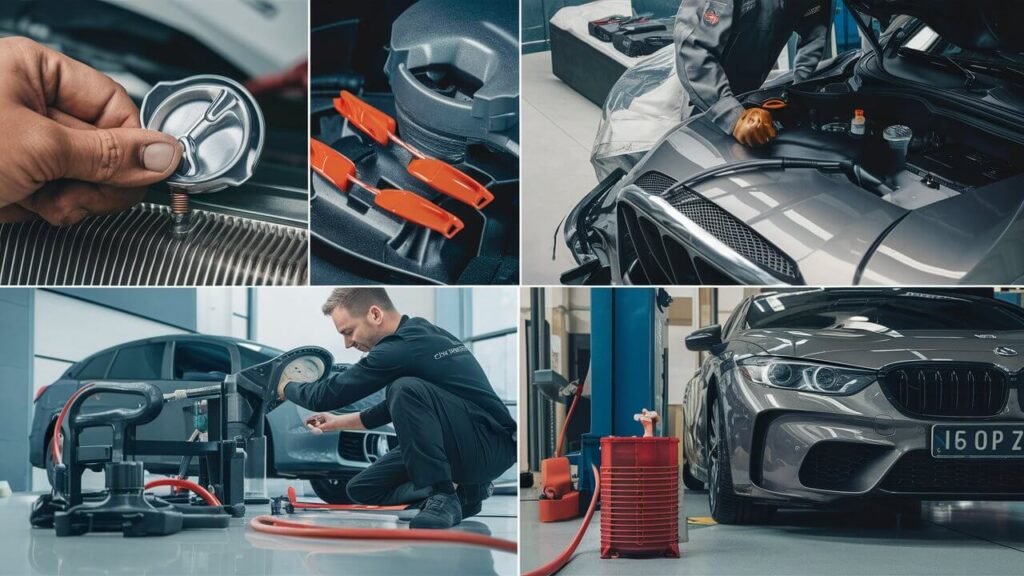
When to Get a Radiator Flush?
Recognizing when your car needs a radiator flush is key to maintaining its health and performance. Ignoring the signs can lead to bigger issues down the road, just like overlooking worn brake pads that compromise safety. So, how do you know it’s time for that all-important car radiator service? Here are a few signs that signal it’s time:
- Radiator Leak
- Discolored Coolant
- Low Coolant Levels
- Strange Noises from Radiator
- Poor Heater Performance
- Coolant Light is On
- Sludge in the Radiator
- Temperature Fluctuations
- Extended Time Since Last Coolant Flush
Keeping an eye out for these signs and acting promptly can save you from costly repairs and ensure your vehicle runs smoothly.
How Often Should You Perform a Radiator Flush?
Maintaining your vehicle’s cooling system through regular radiator flushes is essential for ensuring its long-term performance and preventing costly repairs. But how often should you actually perform a radiator flush? The answer depends on several factors, including your vehicle’s make and model, driving conditions, and the type of coolant used.
Manufacturer Recommendations
Most vehicle manufacturers provide specific guidelines on how often a radiator flush should be performed. These recommendations are typically based on extensive testing and are designed to keep your engine running smoothly. Generally, it’s advised to perform a radiator flush every 30,000 miles or every 3-5 years, whichever comes first. However, it’s crucial to consult your vehicle’s owner’s manual for the exact interval recommended for your specific model.
Factors Influencing Radiator Flush Frequency
-
Driving Conditions:
- City vs. Highway Driving: Vehicles that frequently operate in stop-and-go city traffic may require more frequent radiator flushes due to the higher strain placed on the cooling system. Conversely, highway driving typically puts less stress on the system, potentially extending the interval between flushes.
- Climate: Extreme temperatures, whether hot or cold, can accelerate the degradation of coolant. In hotter climates like Dubai, the cooling system works harder to regulate engine temperature, which may necessitate more frequent maintenance along with regular engine bay cleaning.
-
Coolant Type:
- Traditional vs. Long-Life Coolant: The type of coolant used also affects how often a radiator flush is needed. Traditional green coolant usually requires a flush every two years, while extended-life coolants (often orange or pink) may last up to five years before needing replacement.
-
Vehicle Age and Condition:
- Older Vehicles: As vehicles age, their cooling systems may become more susceptible to corrosion and buildup, making regular flushes more critical. Older vehicles, especially those with higher mileage, might benefit from more frequent radiator flushes to maintain optimal performance.
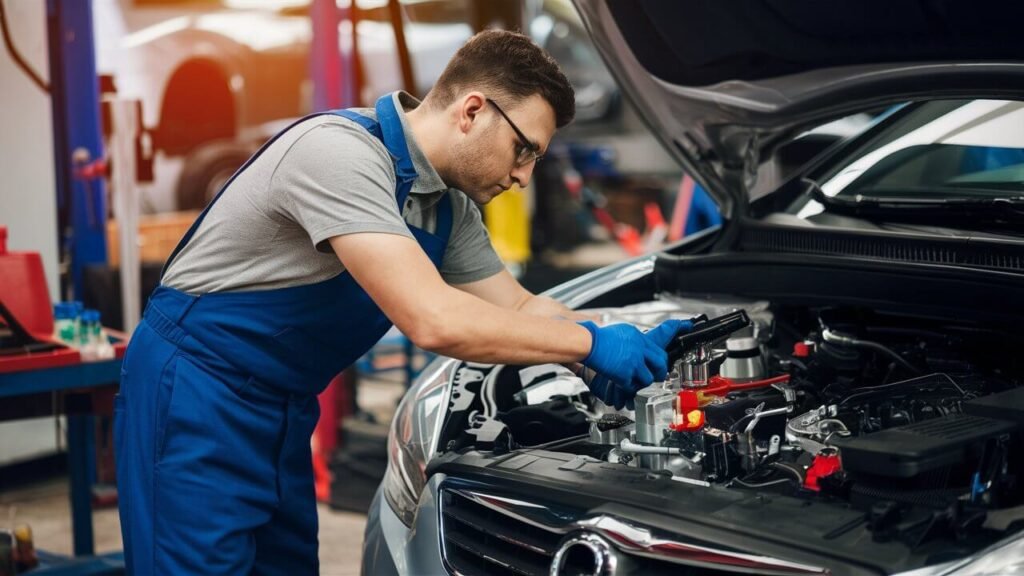
Potential Risks of Skipping Radiator Flushes
This buildup can lead to several issues:
- Reduced Efficiency: The debris can insulate the heat transfer surfaces inside the radiator, making it less efficient at cooling the engine. This can cause the engine to run hotter than normal.
- Clogging: Over time, the buildup can become significant enough to clog the small passages inside the radiator. This restricts the flow of coolant, further reducing the radiator’s ability to cool the engine.
- Corrosion and Damage: Some types of debris, especially if they are acidic or corrosive, can damage the radiator from the inside. This can lead to leaks and a reduction in the structural integrity of the radiator.
- Overheating: The most serious consequence of a debris-filled radiator is overheating of the engine. If the radiator cannot adequately remove heat, the engine temperature can rise to dangerous levels, potentially causing engine damage.
To prevent these issues, it’s important to maintain the radiator properly. This includes regular flushing and cleaning to remove any built-up debris, checking for leaks and damage, and ensuring the coolant is at the correct level and is replaced according to the manufacturer’s recommendations. If the radiator is too clogged or damaged, it may need to be replaced to ensure the efficient operation of your vehicle’s cooling system
Step-by-Step Process of a Radiator Flush
Understanding the process of a radiator flush helps you appreciate the value it brings to your vehicle’s health. Here’s a look at how professionals typically perform a radiator flush:
- Initial Inspection: The service starts with a thorough inspection of the radiator and cooling system to check for leaks or damage.
- Engine Cooling: Before beginning, the technician ensures the engine is completely cool to avoid any risk of injury or damage.
- Draining the Coolant: The old coolant is drained out from the radiator. This involves carefully opening the drain plug and letting the old fluid flow out into a designated container.
- Flushing the System: After draining, a special radiator flush solution is introduced into the system. This solution helps in breaking down and removing any debris, rust, or sediment.
- Refilling with New Coolant: The radiator is then refilled with fresh coolant. This new coolant is usually a mix of antifreeze and water, suitable for your vehicle’s specifications.
- System Check and Leak Test: After the refill, the system is checked for leaks and proper circulation. The technician ensures that the radiator cap and all connections are secure.
- Proper Disposal: The old coolant and flush solution are disposed of responsibly, following environmental safety standards.
This process of a radiator flush, often referred to as a coolant flush or radiator refill, ensures that your vehicle’s cooling system is clean, efficient, and free from potential damage-causing contaminants.
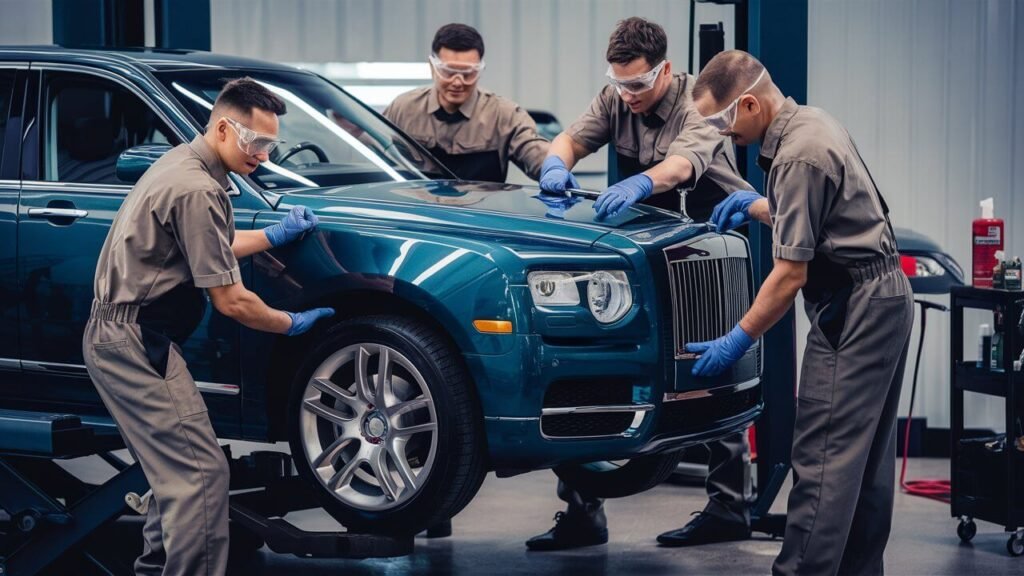
Choosing the Right Coolant for Your Vehicle
Selecting the appropriate coolant is a critical decision for the health of your engine. The right coolant ensures optimal engine temperature regulation and prevents corrosion within the cooling system. Each vehicle has specific requirements, often outlined in the manufacturer’s guide, dictating whether an ethylene glycol or a propylene glycol-based coolant is suitable. A top-grade coolant, matched to your vehicle’s needs, not only enhances the effectiveness of a radiator flush but also ensures smoother operation and prolonged engine life.
Coolant Types and Colors
Understanding the different types and colors of coolant is essential for making an informed decision that benefits your vehicle’s longevity and performance. Coolants are not one-size-fits-all, and the color often indicates specific properties or intended use.
Ethylene Glycol vs. Propylene Glycol:
- Ethylene Glycol-Based Coolants: These are the most common type, offering excellent heat transfer capabilities. However, they are toxic and require careful handling.
- Propylene Glycol-Based Coolants: While slightly less efficient at transferring heat, these coolants are less toxic, making them a safer option, especially in areas where accidental spills might occur.
Coolant Colors:
- Green: Often found in older vehicles, green coolant is typically ethylene glycol-based and requires more frequent changes due to its shorter lifespan.
- Orange: Usually associated with Organic Acid Technology (OAT) coolants, orange coolant is designed to last longer and is often used in GM and other American vehicles. It’s crucial not to mix it with other types.
- Yellow/Gold: A hybrid coolant that combines the properties of both traditional and organic acid technology coolants, offering a middle ground in terms of lifespan and protection.
- Pink/Red: Typically used in newer vehicles, especially from Asian manufacturers, these coolants often contain phosphates and organic acids, providing long-lasting protection against corrosion and scale.
- Blue: Commonly found in European and some Asian vehicles, blue coolant is designed to offer long-term protection, particularly in high-performance engines.
Why Color Matters:
- The color of your coolant is more than just a visual cue; it indicates the chemical composition and intended use. Mixing different types of coolant can lead to chemical reactions that reduce the effectiveness of the coolant and may cause damage to the cooling system. Therefore, always ensure that the coolant you choose matches the manufacturer’s specifications, as outlined in your vehicle’s service manual.
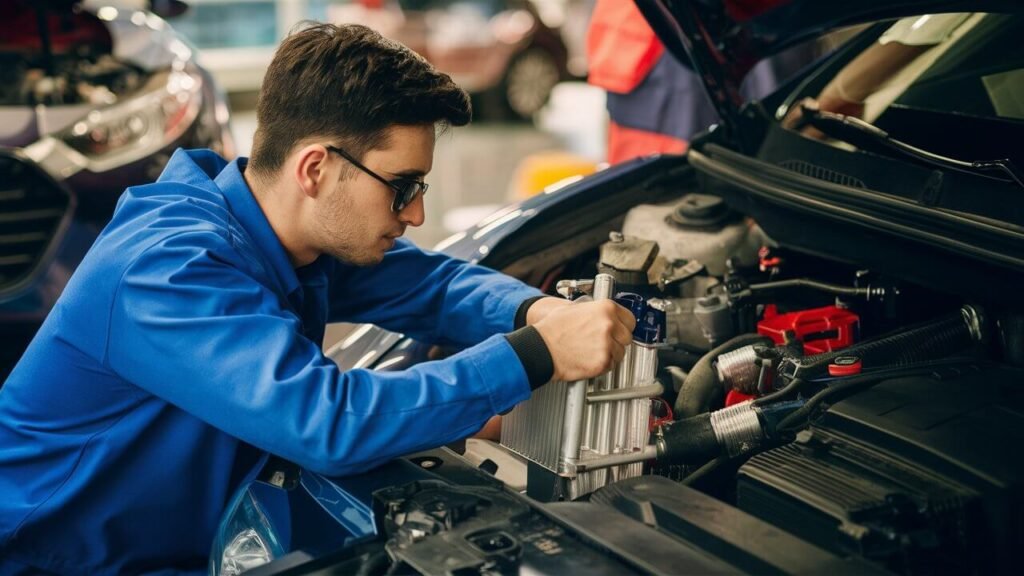
Importance of Matching Coolant to Vehicle Specifications
At Mechanic Autos, we understand the importance of using the right coolant for your vehicle. The correct coolant not only ensures that your engine operates within the optimal temperature range but also protects against internal corrosion, which can significantly extend the lifespan of your cooling system components.
When performing a radiator flush, we always use coolant that matches the specific needs of your vehicle, ensuring compatibility and optimal performance. Whether your vehicle requires a traditional green coolant or a specialized blue or red formula, we make sure that the product used aligns perfectly with the manufacturer’s recommendations.
Benefits of Regular Radiator Maintenance
Regular radiator maintenance is essential for keeping your car running smoothly and preventing problems down the road. Here’s how it benefits your vehicle:
- Prevents Overheating: The radiator is responsible for keeping your engine cool. Regular maintenance ensures that the radiator and coolant are working properly, which helps prevent the engine from overheating. Overheating can lead to serious engine damage, so keeping the radiator in good shape is crucial.
- Improves Engine Efficiency: When your radiator is clean and the coolant is fresh, your engine operates more efficiently. This means your car runs better, uses fuel more effectively, and experiences less wear and tear. Regular maintenance helps your engine perform at its best.
- Extends Engine Life: By keeping the cooling system clean and functioning properly, regular radiator maintenance reduces the risk of rust, corrosion, and buildup. These issues can damage engine components over time, leading to costly repairs. A well-maintained radiator helps extend the life of your engine.
- Reduces Repair Costs: Regular checks and radiator flushes can catch small problems before they become big, expensive ones. Addressing issues early on can save you money by avoiding major repairs or part replacements. It’s a cost-effective way to keep your car in good condition.
- Maintains Vehicle Reliability: A properly maintained radiator ensures your car is reliable, even in extreme weather conditions. Whether it’s a hot summer day or a cold winter morning, regular maintenance keeps your cooling system ready to handle the heat or the chill, giving you peace of mind on the road.
Taking care of your radiator is a simple step that brings big benefits. It keeps your engine cool, improves performance, and helps you avoid costly repairs, ensuring your car stays reliable and safe to drive.
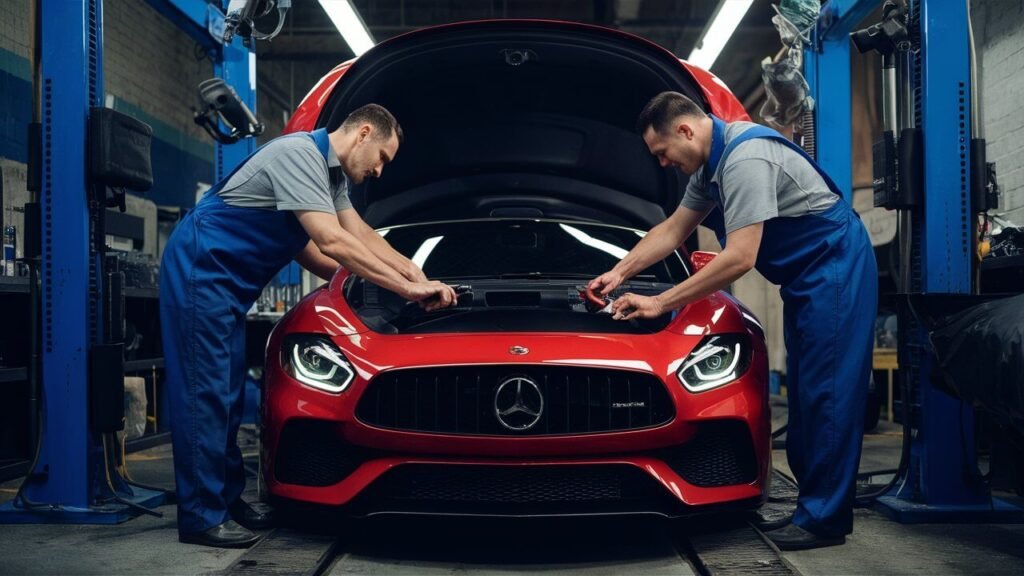
Radiator Flush Cost Estimates
When considering a radiator flush for your vehicle, it’s practical to have an idea about the cost involved. In Dubai, the price for a professional radiator flush, which includes draining the coolant, cleaning the system, and refilling with the appropriate coolant, typically ranges from 200 to 400 AED. This cost can vary depending on your vehicle’s model and the type of coolant it requires. A well-executed coolant change can prevent costly repairs down the line, making it a wise and economical choice for any car owner who values their vehicle’s performance and reliability.
Factors That Affect Cost:
- Type of Vehicle: Larger or more specialized vehicles, like trucks or luxury cars, may cost more because they require more coolant or special handling.
- Location: Prices can vary based on where you live. Labor costs tend to be higher in big cities, so the cost of a radiator flush may be more expensive in those areas.
- Type of Coolant: The kind of coolant used in your vehicle can also affect the price. Some vehicles require specific or high-quality coolants, which can increase the overall cost.
In summary, understanding and maintaining your vehicle’s cooling system through regular radiator flushes is crucial for its optimal performance and longevity. Not only does it keep your engine running smoothly, but it also prevents long-term damage, ensuring your vehicle remains a reliable companion on the road. Remember, investing in timely coolant changes and services is an investment in the health and efficiency of your car, a small step that goes a long way in safeguarding your journey.
